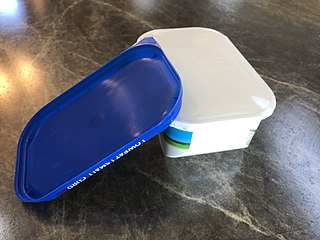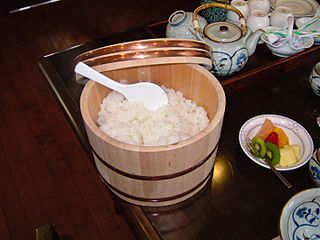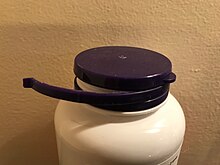A screw cap or closure is a common type of closure for bottles, jars, and tubes.

A bottle cap or bottle top is a closure for the top opening of a bottle. A cap is sometimes colorfully decorated with the logo of the brand of contents. Plastic caps are used for plastic bottles, while metal with plastic backing is used for glass; plastic caps are commonly made from polyethylene or polypropylene, while metal caps are usually either steel or aluminum. Plastic caps may have a pour spout. Flip-Top caps like Flapper closures provide controlled dispensing of dry products. Caps for plastic bottles are often made of a different type of plastic from the bottle.

A jar is a rigid, cylindrical or slightly conical container, typically made of glass, ceramic, or plastic, with a wide mouth or opening that can be closed with a lid, screw cap, lug cap, cork stopper, roll-on cap, crimp-on cap, press-on cap, plastic shrink, heat sealed lidding film, an inner seal, a tamper-evident band, or other suitable means. The English word "jar" originates from the Arabic word jarra, which means an earthen pot or vessel.

A closure is a device used to close or seal a container such as a bottle, jug, jar, tube, or can. A closure may be a cap, cover, lid, plug, liner, or the like. The part of the container to which the closure is applied is called the finish.
Tamper-evident describes a device or process that makes unauthorized access to the protected object easily detected. Seals, markings, or other techniques may be tamper indicating.

A label is a piece of paper, plastic film, cloth, metal, or other material affixed to a container or product, on which is written or printed information or symbols about the product or item. Information printed directly on a container or article can also be considered labelling.

A lid, also known as a cover, is part of a container, and serves as the closure or seal, usually one that completely closes the object. Lids can be placed on small containers such as tubs as well as larger lids for open-head pails and drums. Some lids have a security strip or a tamper-evident band to hold the lid on securely until opening is desired or authorized. These are usually irreversible to indicate that the container has been opened. They can be made of varying materials ranging from plastic to metal.

Tamperproofing, conceptually, is a methodology used to hinder, deter or detect unauthorised access to a device or circumvention of a security system. Since any device or system can be foiled by a person with sufficient knowledge, equipment, and time, the term "tamperproof" is a misnomer unless some limitations on the tampering party's resources is explicit or assumed.

Induction sealing is the process of bonding thermoplastic materials by induction heating. This involves controlled heating an electrically conducting object by electromagnetic induction, through heat generated in the object by eddy currents.

Package pilferage is the theft of part of the contents of a package. It may also include theft of the contents but leaving the package, perhaps resealed with bogus contents. Small packages can be pilfered from a larger package such as a shipping container. Broader and related aspects of package theft may include taking the entire package, pallet load, truck load, shoplifting, etc. The theft may take place at any point in the parcel's journey from source to destination, including theft by rogue logistics employees and customs agents in international mail scenarios.

Pharmaceutical packaging is the packages and the packaging processes for pharmaceutical preparations. It involves all of the operations from production through drug distribution channels to the end consumer.

A shrink tunnel or heat tunnel is a heated tunnel mounted over or around a conveyor system. Items have shrink film loosely applied; with heat, the film shrinks to fit snugly around the wrapped object.

Shelf-ready packaging (SRP) and retail-ready packaging (RRP) refers to the packaging of a product so that it is delivered to a retailer in packaging which is optimized for efficient stocking and sale.

A multi-pack also known as multipack is packaging that combines or holds multiple items or smaller packages.

A clamshell is a one-piece container consisting of two halves joined by a hinge area which allows the structure to come together to close. Clamshells can be made to be reusable and reclosable or can be sealed securely.

Currency packaging includes several forms of packing cash for easy handling and counting. Many systems use standard color-coding or are marked to indicate the amount in the package.

A security bag is a heavy duty bag used to contain high-value products or documents or legally sensitive items. Envelopes with security features are called security envelopes as well as security bags. Cash for deposit in a bank is often placed in a special deposit bag with security features. When used to contain items related to a crime, special evidence bags are used. Authentication of signatures and chain of custody are often required.

Security tape is a type of adhesive tape used to help reduce shipping losses due to pilfering and theft. It helps reduce tampering or product adulteration. Often it is a pressure sensitive tape or label with special tamper resistant or tamper evident features. It can be used as a ‘’security seal’’ in addition to a container closure or can be used as a security label. They are sometimes used as or with authentication products and can be an anti-pilferage seal.

.

Package handles, or carriers, are used to help people use packaging. They are designed to simplify and to improve the ergonomics of lifting and carrying packages. Handles on consumer packages add convenience and help facilitate use and pouring. The effect of handles on package material costs and the packaging line efficiencies are also critical. A handle can be defined as “an accessory attached to a container or part for the purpose of holding or carrying.” Sometimes a handle can be used to hang a package for dispensing or use.


























